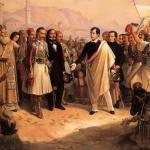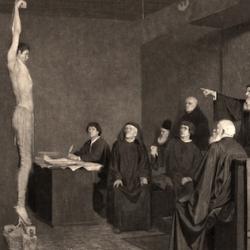Stephen Jay Gould famously offered a solution to the religion v. science conflict: Consign each to its separate corner; they belong to separate domains; they don’t conflict because they don’t overlap. Problem solved.
Not so fast, says John Lennox (Seven Days That Divide the World). One problem is that Gould’s solution often carries the covert implication “that science deals with reality, and religion with Santa Claus, the Tooth Fairy, and God. The impression that science deals with truth and religion deals with fantasy” (27-28).
More importantly, the two contenders won’t stay in their corners. Their subject-matter overlaps: “the Bible talks about some of the things that science talks about,” and Lennox says it’s perfectly legitimate, when warranted, to draw scientific conclusions from Scripture (28).
Good points. But one of Lennox’s extended illustrations of how not to read the Bible scientifically doesn’t fly. He quotes 1 Samuel 2:8 (“the pillars of the earth are the Lord’s, and on them he has set the earth”). Lennox observes:
“We know now that the earth does not rest on literal foundations or pillars made of stone, concrete, or steel. We can therefore see that the words ‘foundations’ and ‘pillars’ are used in a metaphorical sense” (33).
This doesn’t, however, mean that the passage has no scientific value: “the metaphors stand for realities. God the Creator has built certain very real stabilities into the planetary system that will guarantee its existence so long as is necessary to fulfil his purposes. Science has been able to show us that the earth is stable in its orbit over long periods of time, thanks in part to the obedience of gravity to an inverse square law, to the presence of the moon, which stabilises the tilt of earth’s axis, and to the existence of the giant planet Jupiter, which helps keep the other planets in the same orbital plane. Earth’s stability, therefore, is very real. It is, if you wish, a literal or true stability, even though it does not now make sense to understand the word stability literalistically, as referring to motionlessness” (33).
But a glance at the context indicates that Lennox has solved a problem that the text never raises. The text is from Hannah’s song, and she’s speaking of a social not a physical world. Earlier in 1 Samuel 2:8, she praises Yahweh for raising the poor to enthrone them with nobles, and she ends with the confidence that the Lord will “shatter” those who fight Him. The pillars are the leaders on whom the political world rests.
We know now that the world doesn’t rest on pillars, Lennox said. But the text he cites offers no evidence that people then believed otherwise. The verse develops an analogy between a house or temple and human society; if there’s a cosmic picture in view, it views the universe is a house too.
That is “literal” in the sense that God created creation as a place to dwell. But the analogy tells us nothing one way or another about whether ancient Israelites believed that the universe, the earth, or the sky rests on physical pillars.












